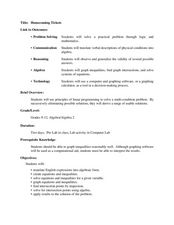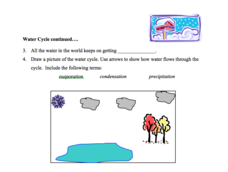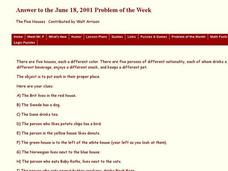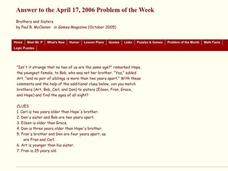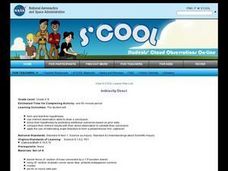Curated OER
Homecoming Tickets
Students solve word problems using systems of equation. In this algebra lesson, students use computer and graphing to graph and analyze their solution. They solve system involving inequalities.
Curated OER
Who Lives Where?
In this reasoning worksheet, students read clues about which house each of 6 people live in. Students use reasoning to determine the correct house for each person and label it with the correct name.
Curated OER
Using Connectors: Because and Though
For this using connectors: because and though worksheet, students red the explanations and examples for using these two conjunctions, then interactively complete 20 sentences using the correct words or punctuation, with immediate online...
Curated OER
Click, Clack, Moo: Electric Blanket Science
Students read Click, Clack, Moo: Cows That Type by Doreen Cronin and discuss the similarities and differences between electric blankets and regular blankets. They brainstorm a list of reasons why the farm animals wanted electric blankets.
Curated OER
Sopay Water
Tenth graders design and conduct an experiment to explore the use of several substances in removing soap from water. During this activity they work with a lab partner. They keep their own individual lab notes, after they finish, they...
Curated OER
Track Meet
In this reasoning worksheet, 3rd graders look over a table with statistics and solve the answers to 5 word problems related to the table about a class track meet.
Curated OER
True or False?
In this whole numbers reasoning worksheet, 3rd graders read, analyze and circle true or false to 8 math statements as they figure out if the statements are correctly stated or not.
Curated OER
Probability and Statistics
Learners reason mathematically as they solve problems dealing with probability of an even occurring. In this probability lesson plan, students differentiate between different rankings of candidates running for leadership. They identify...
Curated OER
Possibility / Impossibility in the Past
In this possibility/impossibility in the past tense worksheet, students read for information and use could have and couldn't have to practice usage and logical reasoning. Students write fourteen answers.
Curated OER
Compare Length and Height
In this comparing length and height word problem learning exercise, students compare drawings of objects visually to determine which is longer, longest, shorter, and shortest and make a chart to solve logical reasoning problems. Students...
Curated OER
Mathematical Magazines
Learners use ads from magazines to create data to be measured and apply the skill of estimation. They record the percentage of magazine ads that could be separated into different categories made by students through the use of logical...
Curated OER
Water, Water Everywhere!
Learners brainstorm on ways they use water, and where water comes from. They view video, Down the Drain, to gain specific facts about water use, properties of water, problems of water and the water cycle. They perform a lab activity...
Curated OER
Developing Thinking and Reasoning Skills in Primary Learners Using Detective Fiction
Students are introduced to the genre of detective fiction. Based on their reading level, they are given a different series of books to read. For each story, they are to make predictions and practice decoding messages. To end the...
Curated OER
Three Reasons Why I Want To Be...
Students investigate the process of writing an expository paper. The purpose of the paper is established in the introduction and the supporting details are sequenced in a logical order. The paper possesses punctuation and grammatical...
Curated OER
The Five Houses
For this deductive reasoning worksheet, students use clues to tell the nationality, beverage, snack, house color and pet of five people.
Curated OER
Brothers and Sisters
In this deductive reasoning worksheet, students use 7 clues to determine the ages and relationships of 8 people. The page opens to the answer sheet.
Curated OER
Explore Subtraction
Learnersare given 26 tables and graphs in which they must fill in missing numbers and graph equations. They subtract a given value of x from a constant number, and use a number line to subtract larger numbers from smaller ones resulting...
Bowland
Fruit Pies
Scholars use formulas for the area of a circle and the area of a rectangle to determine the number of pies a baker can make from a particular area of dough. They must also take into account rolling the remaining dough into a new sheet.
Alabama Learning Exchange
Polygons-Changing Area Versus Changing Perimeter
Investigate the area and perimeter of polygons in this geometry lesson. Young geometers use grid paper to draw a quadrilateral and calculate its area and perimeter. They also read The Greedy Triangle to identify the changing shape of...
Pennsylvania Department of Education
Tell Me Again
Students demonstrate how to retell a story in sequential order. In this reading comprehension instructional activity, students listen to a suggested read aloud, such as Little Boy Blue. Additionally, students practice retelling the story...
Curated OER
Vocabulary Review
In this vocabulary review, students use context clues to choose answers to complete sentences. Students determine a word or words to logically complete seven sentences.
Curated OER
Indirectly Direct
Learners use prior knowledge of angle and lines as they conduct an experiment with a rolling marble to determine the shape of a mystery object located under a metal pie tin.
Curated OER
"The Island of Plenty": Reading Guide
Johnson C. Montgomery’s controversial plea for American social isolationism, “The Island of Plenty,” launches an in-depth study of the structure and logic of the essay. After responding to a series of questions, individuals craft a...
Curated OER
Two Squares are Equal
This problem is sure to get your young mathematicians thinking. The idea sounds simple: one equation, solve it as many ways as you can. This is meant to get at a deeper understanding of solving quadratic equations, including some more...


